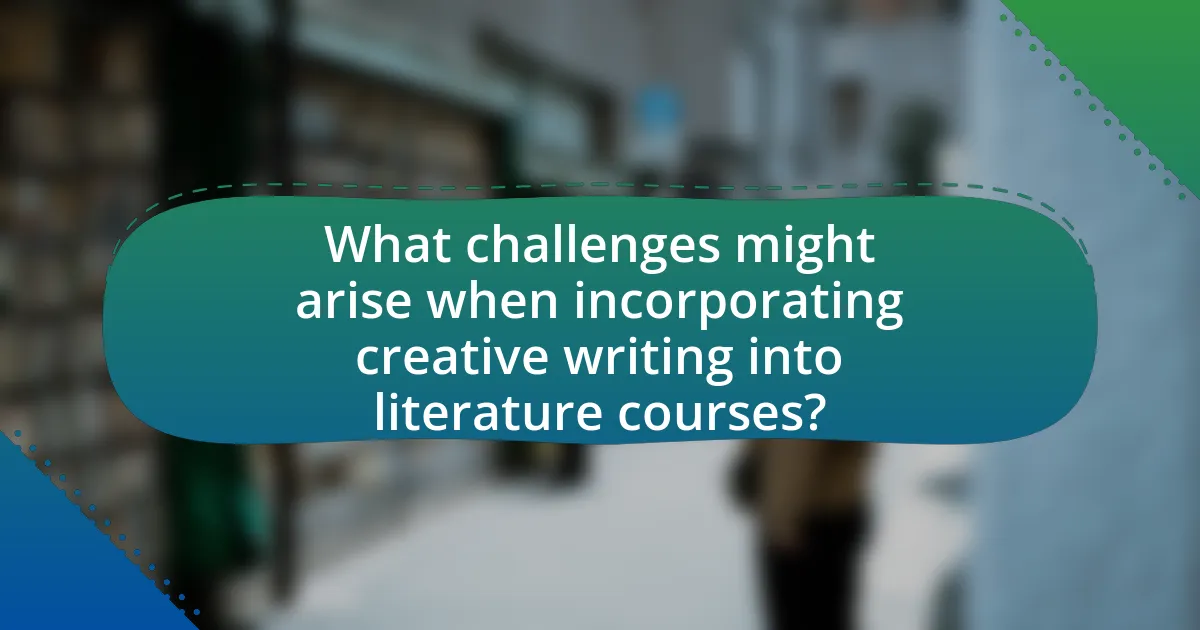Incorporating creative writing into traditional literature courses enhances students’ understanding of narrative techniques, character development, and thematic exploration. This integration fosters critical thinking and deeper engagement with literature, as students apply theoretical concepts through their own creative work. The article discusses the specific skills developed through creative writing, such as critical thinking and emotional intelligence, and highlights effective methods for blending creative writing with literary analysis. Additionally, it addresses potential challenges and offers strategies for educators to create a supportive environment that promotes creativity and collaboration among students.

What does it mean to incorporate creative writing into traditional literature courses?
Incorporating creative writing into traditional literature courses means integrating imaginative writing exercises and assignments alongside the study of established literary texts. This approach enhances students’ understanding of narrative techniques, character development, and thematic exploration by allowing them to practice writing in various styles and genres. Research indicates that such integration fosters critical thinking and deeper engagement with literature, as students apply theoretical concepts in their own creative work, thereby reinforcing their analytical skills.
How can creative writing enhance the study of traditional literature?
Creative writing enhances the study of traditional literature by fostering deeper engagement and understanding of literary themes and techniques. When students create their own narratives, they actively apply the stylistic elements and structures found in traditional texts, which reinforces their comprehension of those works. Research indicates that students who engage in creative writing exercises demonstrate improved analytical skills and a greater appreciation for the nuances of language, as evidenced by studies showing that writing about literature can lead to higher levels of critical thinking and retention of material.
What specific skills does creative writing develop in literature students?
Creative writing develops critical thinking, narrative construction, and emotional intelligence in literature students. Critical thinking is enhanced as students analyze their own work and the works of others, fostering the ability to evaluate and interpret texts deeply. Narrative construction skills are developed through the practice of creating plots, characters, and settings, which helps students understand the mechanics of storytelling. Emotional intelligence is cultivated as students explore diverse perspectives and express complex emotions in their writing, leading to greater empathy and understanding of human experiences. These skills are essential for effective communication and interpretation in both academic and personal contexts.
How does creative writing foster a deeper understanding of literary themes?
Creative writing enhances the comprehension of literary themes by allowing individuals to engage with and explore these themes through personal expression and narrative construction. When individuals create their own stories, they must analyze and interpret existing themes, which deepens their understanding of the underlying messages and motifs present in literature. Research indicates that students who participate in creative writing exercises demonstrate improved analytical skills and a greater ability to identify thematic elements in texts, as evidenced by studies showing that such practices lead to higher scores in literary analysis assessments. This active engagement with themes through writing fosters a more profound appreciation and insight into the complexities of literature.
Why is it important to blend creative writing with traditional literature?
Blending creative writing with traditional literature is important because it enhances students’ understanding and appreciation of literary techniques and themes. This integration allows students to engage with texts on a deeper level, fostering critical thinking and creativity. Research indicates that students who participate in creative writing exercises alongside traditional literature courses demonstrate improved analytical skills and a greater ability to interpret complex narratives. For instance, a study published in the Journal of Creative Writing Studies found that students who wrote creatively about literary works were more adept at identifying literary devices and themes, thus reinforcing the value of this blended approach in educational settings.
What are the potential benefits for students in this integrated approach?
The potential benefits for students in the integrated approach of incorporating creative writing into traditional literature courses include enhanced engagement, improved critical thinking skills, and increased creativity. This integration allows students to actively participate in the learning process by expressing their interpretations of literary works through their own writing, which fosters a deeper understanding of the material. Research indicates that students who engage in creative writing alongside literature analysis demonstrate higher levels of comprehension and retention of themes and concepts, as they are able to connect personally with the texts. Additionally, studies show that this approach can lead to improved writing skills, as students practice various styles and techniques, ultimately enhancing their overall academic performance.
How does this integration reflect contemporary literary practices?
The integration of creative writing into traditional literature courses reflects contemporary literary practices by emphasizing experiential learning and the blending of genres. This approach aligns with current educational trends that prioritize student engagement and the development of personal voice in writing. Research indicates that such integration fosters critical thinking and creativity, essential skills in today’s literary landscape, where hybrid forms and interdisciplinary approaches are increasingly valued. For instance, a study by the National Council of Teachers of English highlights that students who engage in creative writing alongside literary analysis demonstrate improved analytical skills and a deeper understanding of narrative techniques.

What methods can be used to incorporate creative writing into literature courses?
Incorporating creative writing into literature courses can be achieved through methods such as writing prompts, peer workshops, and thematic projects. Writing prompts encourage students to respond creatively to literary texts, fostering personal engagement and interpretation. Peer workshops facilitate collaborative feedback, allowing students to refine their writing skills while learning from each other’s perspectives. Thematic projects enable students to explore specific literary themes through their own creative narratives, deepening their understanding of the material. These methods have been shown to enhance critical thinking and creativity, as evidenced by studies indicating that students who engage in creative writing demonstrate improved analytical skills and a greater appreciation for literature.
What types of creative writing exercises are most effective in literature classes?
Effective creative writing exercises in literature classes include character development, dialogue writing, and poetry composition. Character development exercises encourage students to create detailed profiles for fictional characters, enhancing their understanding of narrative depth. Dialogue writing tasks help students practice voice and tone, fostering skills in realistic conversation. Poetry composition allows for exploration of language and form, promoting creativity and emotional expression. Research indicates that these exercises improve students’ engagement and comprehension of literary techniques, as evidenced by studies showing increased analytical skills and creativity in students who participate in such activities.
How can prompts from classic literature inspire creative writing assignments?
Prompts from classic literature can inspire creative writing assignments by providing rich themes, complex characters, and timeless conflicts that stimulate students’ imagination. For instance, the exploration of existential themes in Dostoevsky’s “Crime and Punishment” can lead students to create narratives that delve into moral dilemmas and psychological depth. Additionally, the intricate character development found in Jane Austen’s works can encourage students to craft their own character-driven stories, reflecting societal norms and personal growth. Research indicates that engaging with classic texts enhances critical thinking and creativity, as students draw connections between historical contexts and contemporary issues, thereby enriching their writing skills.
What role does peer feedback play in creative writing within literature courses?
Peer feedback plays a crucial role in enhancing the creative writing process within literature courses by fostering collaboration and critical thinking among students. This interaction allows writers to receive diverse perspectives on their work, which can lead to improved writing skills and greater confidence in their abilities. Research indicates that peer feedback encourages students to engage more deeply with the material, as they must analyze and articulate their thoughts on others’ writing, thereby reinforcing their own understanding of narrative techniques and stylistic choices. Studies have shown that students who participate in peer review sessions often demonstrate higher levels of creativity and originality in their writing, as they are inspired by the ideas and approaches of their peers.
How can instructors assess the effectiveness of creative writing integration?
Instructors can assess the effectiveness of creative writing integration by evaluating student engagement, improvement in writing skills, and the depth of literary analysis. Engagement can be measured through participation in creative writing assignments and discussions, indicating students’ interest and investment in the material. Improvement in writing skills can be tracked through pre- and post-assessments, showing measurable growth in areas such as creativity, structure, and voice. Additionally, the depth of literary analysis can be assessed through reflective essays or projects that require students to connect their creative work with literary concepts, demonstrating their understanding of both creative and analytical writing. These methods provide concrete evidence of the impact of creative writing on students’ learning outcomes.
What criteria should be used to evaluate student creative writing in literature contexts?
The criteria used to evaluate student creative writing in literature contexts should include originality, coherence, character development, thematic depth, and stylistic choices. Originality assesses the uniqueness of ideas and perspectives presented in the writing. Coherence evaluates the logical flow and organization of the narrative, ensuring that the story is easy to follow. Character development examines how well characters are fleshed out, including their motivations and growth throughout the piece. Thematic depth looks at the complexity and relevance of the themes explored, determining how effectively the writing engages with significant concepts. Stylistic choices focus on the use of language, including tone, voice, and literary devices, which contribute to the overall impact of the writing. These criteria are supported by educational frameworks that emphasize the importance of these elements in fostering effective creative expression in literature.
How can student reflections enhance the assessment process?
Student reflections can enhance the assessment process by providing insights into individual learning experiences and thought processes. These reflections allow educators to gauge students’ understanding, identify areas of confusion, and tailor instruction to meet diverse needs. Research indicates that reflective practices can lead to deeper learning outcomes, as students articulate their thoughts and feelings about the material, fostering critical thinking and self-assessment skills. For instance, a study published in the Journal of Educational Psychology found that students who engaged in reflective writing demonstrated improved academic performance and greater engagement with course content.

What challenges might arise when incorporating creative writing into literature courses?
Incorporating creative writing into literature courses may lead to challenges such as differing skill levels among students and potential conflicts between creative expression and literary analysis. Students often possess varying degrees of writing proficiency, which can create disparities in participation and engagement. Additionally, the subjective nature of creative writing may clash with the objective analysis typically emphasized in literature courses, making it difficult for instructors to balance both approaches effectively. Research indicates that these challenges can hinder the overall learning experience, as students may struggle to integrate creative techniques with critical literary concepts.
How can instructors address resistance from students or faculty?
Instructors can address resistance from students or faculty by fostering open communication and demonstrating the value of creative writing in enhancing literary understanding. Engaging students and faculty in discussions about the benefits of creative writing, such as improved critical thinking and deeper emotional connections to texts, can help alleviate concerns. Research indicates that integrating creative writing into literature courses can lead to increased student engagement and retention of material, as evidenced by studies showing that students who participate in creative writing exercises often perform better in literary analysis (Graham, 2018, Journal of Educational Psychology). By providing concrete examples of successful integration and encouraging feedback, instructors can create a collaborative environment that reduces resistance.
What strategies can be employed to overcome skepticism about creative writing?
To overcome skepticism about creative writing, educators can implement experiential learning strategies that demonstrate its value in enhancing critical thinking and analytical skills. Research indicates that integrating creative writing into traditional literature courses fosters deeper engagement with texts, as students learn to interpret and analyze literature through their own creative expressions. For instance, a study by the National Council of Teachers of English found that students who participated in creative writing exercises showed a 20% increase in their ability to analyze literary themes compared to those who did not engage in such activities. By showcasing these benefits and providing structured opportunities for students to practice creative writing, educators can effectively address skepticism and highlight its relevance in literary studies.
How can instructors balance creative writing with traditional literary analysis?
Instructors can balance creative writing with traditional literary analysis by integrating both practices into a cohesive curriculum that emphasizes the relationship between creativity and critical thinking. This approach allows students to engage with texts through creative expression while simultaneously analyzing literary elements such as theme, structure, and style. Research indicates that when students write creatively in response to literature, they develop a deeper understanding of the material, as evidenced by a study published in the Journal of Creative Writing Studies, which found that students who participated in creative writing exercises demonstrated improved analytical skills and greater engagement with the texts. By fostering an environment where creative writing complements literary analysis, instructors can enhance students’ overall comprehension and appreciation of literature.
What resources are available to support the integration of creative writing?
Resources available to support the integration of creative writing include writing workshops, online platforms, and educational curricula designed specifically for this purpose. Writing workshops, such as those offered by the Association of Writers & Writing Programs, provide structured environments for students to practice and develop their creative writing skills. Online platforms like Wattpad and Scribophile allow writers to share their work and receive feedback from peers, fostering a community of practice. Additionally, educational curricula that incorporate creative writing, such as those developed by the National Council of Teachers of English, provide frameworks and lesson plans that educators can use to blend creative writing with traditional literature studies. These resources collectively enhance the learning experience by promoting creativity and critical thinking in literature courses.
What books or materials can enhance the teaching of creative writing in literature courses?
Books and materials that can enhance the teaching of creative writing in literature courses include “The Writing Life” by Annie Dillard, which offers insights into the creative process, and “Bird by Bird” by Anne Lamott, providing practical advice on writing and the writing life. Additionally, “Writing Down the Bones” by Natalie Goldberg emphasizes the importance of practice and mindfulness in writing. These texts are widely recognized for their ability to inspire and guide both instructors and students in the creative writing process, making them valuable resources in literature courses.
How can online platforms facilitate creative writing collaboration among students?
Online platforms can facilitate creative writing collaboration among students by providing tools for real-time communication, shared document editing, and feedback mechanisms. These platforms, such as Google Docs and collaborative writing apps, allow multiple users to contribute simultaneously, enhancing the collaborative experience. Research indicates that collaborative writing can improve writing skills and foster a sense of community among students, as highlighted in a study by Storch (2005) in the “Journal of Second Language Writing,” which found that peer interaction during writing tasks leads to better outcomes. Additionally, online forums and discussion boards enable students to share ideas and receive constructive criticism, further enriching the collaborative writing process.
What best practices should educators follow when incorporating creative writing?
Educators should prioritize fostering a supportive environment when incorporating creative writing. This involves encouraging students to express their ideas freely without fear of judgment, which enhances creativity and engagement. Research indicates that a positive classroom atmosphere significantly boosts student motivation and willingness to participate in writing activities. Additionally, providing structured prompts and guidelines can help students focus their creativity while still allowing for personal expression. Studies show that clear expectations lead to improved writing outcomes, as students understand the objectives and can better align their work with them. Regular feedback is also essential; it should be constructive and aimed at guiding improvement, as feedback has been shown to enhance writing skills and confidence. Lastly, integrating peer review sessions can promote collaboration and critical thinking, as students learn to evaluate each other’s work and gain new perspectives.
How can educators create a supportive environment for creative expression?
Educators can create a supportive environment for creative expression by fostering open communication and encouraging risk-taking in the classroom. This involves establishing a safe space where students feel comfortable sharing their ideas without fear of judgment. Research indicates that environments that promote psychological safety enhance creativity; for instance, a study published in the Journal of Creative Behavior found that students who perceive their classroom as supportive are more likely to engage in creative tasks. Additionally, providing constructive feedback and celebrating diverse perspectives further nurtures creativity, as it validates students’ unique contributions and encourages them to explore their creative potential.
What tips can help educators effectively blend creative writing with literary study?
Educators can effectively blend creative writing with literary study by integrating writing exercises that respond to literary texts. This approach encourages students to engage deeply with the material, fostering both analytical and creative skills. For instance, after reading a poem, students can be tasked with writing their own poem that reflects similar themes or styles, which enhances their understanding of poetic devices and structure. Research indicates that such experiential learning methods improve comprehension and retention of literary concepts, as students actively apply what they learn in a creative context.




